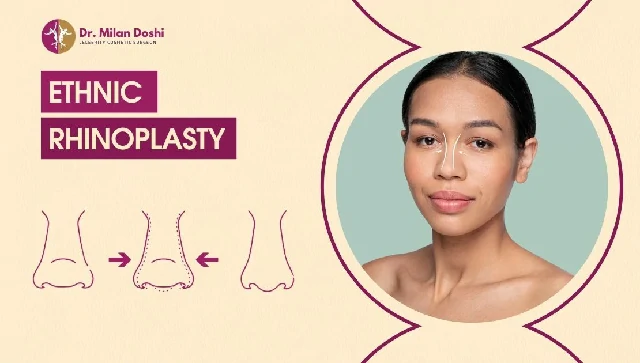Introduction
Nose plays an important role in your facial harmony. However, ethnic features such as a wide nasal base, flat bridge, or thick skin can sometimes cause dissatisfaction.
This may lead you feeling self-conscious most of the time and longing for a balanced facial profile. Traditional rhinoplasty often overlooks the unique needs of diverse ethnicities, risking results that feel unnatural or erase cultural identity.
What is Ethnic Rhinoplasty?
Medical Definition: Ethnic rhinoplasty is specialized cosmetic nose surgery that reshapes the nose to enhance facial features, preserving your cultural identity.
Unlike traditional rhinoplasty, which aims for standardized beauty ideals, ethnic rhinoplasty celebrates diversity, focusing on harmony and individuality.
A study published by Science Direct, reported 1321 people after taking ethnic rhinoplasty experienced a satisfactory result with their nose. The study also said, no cases of nasal contracture were recorded from the participants.
Dr. Milan Doshi, celebrity cosmetic surgeon and founder of Allure Medspa after assessing diverse nose types of patients visiting him from across India and foreign countries for the past 25 years says, “ethnic rhinoplasty surgery is complex and requires detailed knowledge about the patients ethnic background that includes individuals native-place, climatic conditions, skill, will, and an artistic finesse in identifying the best possible nose profile that doesn’t compromise on patients ethnic identity.
Understanding Ethnic Rhinoplasty
Ethnic rhinoplasty is tailored to address the specific needs of your ethnic background. Every ethnicity has distinct nasal features influenced by genetics, environment, and cultural beauty standards.
The goal of ethnic rhinoplasty surgery is not to erase these features but to refine them subtly, ensuring that the results complement your facial structure while honoring your heritage.
What nose problems are fixed by Ethnic Rhinoplasty?
Ethnic rhinoplasty can fix your:
- Wide nasal base
- Flat nasal bridge
- Bulbous nasal tip
- Nose’s thick skin
What techniques are used in Ethnic Rhinoplasty surgery?
Ethnic rhinoplasty employs a range of techniques to achieve desired results. These include:
- Cartilage grafting: Cartilage from your own body (e.g., ear or rib) is used to build and reshape nasal structure.
- Bridge augmentation: Synthetic implants and autologous tissue are used to enhance your nasal bridge.
- Alar base reduction: Techniques like nostril narrowing help you achieve a more proportionate nasal base.
- Soft tissue adjustments: Careful handling of thick skin or fatty tissues ensures a balanced and natural outcome.
Who is the Right Surgeon for Ethnic Rhinoplasty?
Choosing an experienced surgeon in ethnic rhinoplasty procedures is crucial to achieving optimal results.
A right surgeon will:
- Have extensive experience with ethnic rhinoplasty.
- Demonstrate a detailed understanding of ethnic facial anatomy.
- Respect the patient’s aesthetic goals and cultural identity.
- Use advanced techniques to minimize scarring and ensure natural outcomes.
Recovery and Result of Ethnic Rhinoplasty
Recovery from ethnic rhinoplasty takes 6 to 10 weeks, with visible improvements. The results of ethnic rhinoplasty surgery are permanent and life-enhancing, boosting confidence and helping you feel more comfortable in your skin.
Embracing Your Unique Beauty with Ethnic Rhinoplasty
Ethnic rhinoplasty is about embracing and enhancing what makes you unique. By choosing this personalized approach done by an experienced cosmetic surgeon Dr. Milan Doshi, you can achieve a nose that harmonizes with your facial features, respects your heritage, and empowers you to feel your best.
In the end, ethnic rhinoplasty celebrates individuality, proving that beauty truly lies in diversity.
